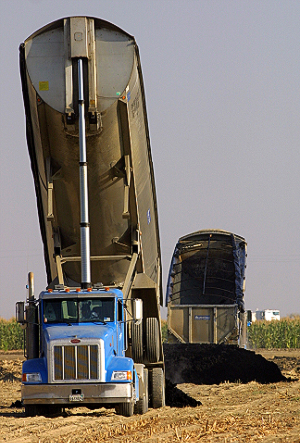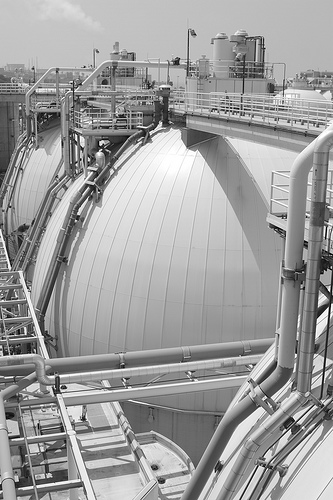 Should what we put down our sewers ultimately wind up back on our plates?Marc Samsom via Flickr
Should what we put down our sewers ultimately wind up back on our plates?Marc Samsom via Flickr
Urine, feces, menstrual blood, hair, fingernails, vomit, dead skin cells. Industrial chemicals, pharmaceuticals, soaps, shampoos, solvents, pesticides, household cleansers, hospital waste.
Sewage sludge, the viscous brown gunk left over when wastewater is treated, is more than just poop: it’s an odiferous smoothie of everything we pour down the drain. There are pathogens; there are heavy metals. PCBs, dioxins, DDT, asbestos, polio, parasitic worms, radioactive material — all have been found in sludge. Despite pretreatment programs that prevent some of the most noxious stuff from entering the public sewers, sludge can include so many toxins that the Clean Water Act lists it as a “pollutant.”
So it’s a little surprising where it ends up: Today more than half of America’s sewage sludge is spread on land as fertilizer.
Granted, this isn’t a new idea. For most of human history, our crap has ended up back on land — and it wasn’t until the past century, which brought flush toilets and public sewers to mainstream America, that using excrement as fertilizer started sounding at all strange. Sure, this system was driven partially by convenience, but it also made ecological sense: our urine and feces contain the same nutrients that plants need. Spreading it on land closes the nutrient loop; it avoids the need for chemical fertilizers. Eat, shit, fertilize, and eat again. For thousands of years, this arrangement worked just fine.
Or, rather, almost fine. As human populations grew and concentrated, health problems like cholera outbreaks inspired a push for flush toilets and public sewer systems. This led to huge improvements in public health, but resulted in a new problem: sewers mixed domestic sewage with industrial waste and spewed it untreated into rivers and lakes. The next step was sewage treatment plants, which separated liquids from solids, but in solving one issue they created yet another: the cleaner they made the water, the dirtier the leftover sludge. Adding to the challenge, as the population of the United States grew, so did the amount of sludge: we’re currently generating more than 7 million dry tons a year and counting — and we have no intention of cutting back.
Meanwhile, as a mycelium of sewer pipes spreads underneath our cities to whisk our waste away from us, Americans became increasingly squeamish about dealing with excrement. We’re now a nation of “fecaphobes,” obsessed with toilet humor but unaware and uninterested in what happens to our actual crap. We don’t want to think about it; we don’t want to deal with it. We want to flush the toilet and forget.
**
 Sludge from Los Angeles is dumped at Green Acres, a Los Angeles-owned farm in Kern County, California.Courtesy Bakersfield CalifornianThe Office of Water doesn’t have the privilege of forgetting about sludge — it’s the Environmental Protection Agency department responsible for dealing with America’s sewage. In the 1990s its job got even harder: sewers and wastewater treatment facilities mandated by the 1972 Clean Water Act more than doubled the amount of sludge America produced each year, and the 1988 Ocean Dumping Act eliminated the option of getting rid of it at sea. The OW had been encouraging land application on a limited scale since the 1970s. Now, faced with limited options and a never-ending supply, it evaluated its remaining possibilities — landfilling, incineration, or land application — and settled on the cheapest option available: promoting sludge as fertilizer.
Sludge from Los Angeles is dumped at Green Acres, a Los Angeles-owned farm in Kern County, California.Courtesy Bakersfield CalifornianThe Office of Water doesn’t have the privilege of forgetting about sludge — it’s the Environmental Protection Agency department responsible for dealing with America’s sewage. In the 1990s its job got even harder: sewers and wastewater treatment facilities mandated by the 1972 Clean Water Act more than doubled the amount of sludge America produced each year, and the 1988 Ocean Dumping Act eliminated the option of getting rid of it at sea. The OW had been encouraging land application on a limited scale since the 1970s. Now, faced with limited options and a never-ending supply, it evaluated its remaining possibilities — landfilling, incineration, or land application — and settled on the cheapest option available: promoting sludge as fertilizer.
To make this palatable to the American people — or, at least, to prevent them from thinking about it too hard — the word “sludge” had to go. So the sewage industry’s main trade and lobbying organization, the Water Environment Federation, stepped in. (WEF and OW often work closely together.) It organized a “Name Change Taskforce” and sponsored a contest to come up with a different term for sludge. Rebranding was an area in which WEF had experience — originally founded in 1928 as the brown-sounding “Federation of Sewage Works Associations,” it had recently gone through its fourth name change, and had begun referring to its members, who included sewage plant operators and waste management corporations, as “water quality professionals.”
The renaming contest received over 250 entries, many of which suggested that even water quality professionals still enjoy a good poop joke. Submissions included “bioslurp,” “black gold,” “sca-doo,” “hu-doo,” “geoslime,” and “the end product”; one person proposed rebranding sludge as “R.O.S.E.” (“Recycling Of Solids Environmentally”). Critics asked whether a rose by any other name would still smell as bad, and in 1991 WEF settled on “biosolids,” a term that Sheldon Rampton, co-author of Toxic Sludge Is Good For You, suggests “must have been chosen precisely because it evokes absolutely nothing in the minds of people who hear it.”
Of course, from the wastewater treatment industry’s perspective, that was the point: they didn’t want any visuals. Armed with an empty word, their next goal was to make “biosolid” suggest something positive. So in 1992, OW and WEF joined in a “cooperative agreement” called the Biosolids National Public Acceptance Campaign and hired a public relations and lobbying firm called Powell Tate to produce a report on how to improve the public image of sludge.
The resulting campaign — “Biosolids 2000” — didn’t answer important questions, like why people living near biosolids application sites complained of health problems, or why current federal legislation still permits every business, institution and industry in the country to dump 15 kilograms (33 pounds) of untreated hazardous waste into the sewer system each month, no reporting required. It also failed to prevent 2000 and 2002 reports from EPA’s own Office of Inspector General from stating that “EPA cannot assure the public that current land application practices are protective of human health and the environment.”
And yet partially because of OW and WEF’s PR efforts, partially because of our willful ignorance, the effort to rebrand sludge as biosolids has largely been successful. Although some is still incinerated or buried in landfills, today more than 50 percent of America’s sewage sludge is spread on land.
***
 Biosolid digesters at the Hyperion Treatment Plant in Los Angeles.Courtesy Brian RaimondiDiane Gilbert, a spokesperson for biosolids at the Hyperion Wastewater Treatment Plant in Los Angeles, is a water quality professional of the sort endorsed by the Powell Tate report. Her enthusiasm seems genuine, but like other biosolids spokespeople I interviewed, she is also a master at following the guidelines articulated in biosolids media training guides. [Sample tip: “If the reporter asks rapid fire (multiple questions), choose the easiest.”]
Biosolid digesters at the Hyperion Treatment Plant in Los Angeles.Courtesy Brian RaimondiDiane Gilbert, a spokesperson for biosolids at the Hyperion Wastewater Treatment Plant in Los Angeles, is a water quality professional of the sort endorsed by the Powell Tate report. Her enthusiasm seems genuine, but like other biosolids spokespeople I interviewed, she is also a master at following the guidelines articulated in biosolids media training guides. [Sample tip: “If the reporter asks rapid fire (multiple questions), choose the easiest.”]
Enthusiastic and bubbly, Gilbert grew up in Louisiana and has been at Hyperion since 1987. But Gilbert’s involvement with sewage sludge started even earlier; with a father who worked at a wastewater treatment plant and used sludge to fertilize the family’s garden, she considers herself a poster child for land application. “I’ve been eating food fertilized with biosolids for as long as I can remember,” she told me, after I’d returned from a tour of the plant. (Tip: “Encourage the reporter to meet you at a working location.”) “So if anyone should be affected by biosolids, it should clearly be me.”
I’d come to Hyperion because I wanted to learn more about this mysterious brown substance — how it was made, how it was monitored, and how worried we should be. Eager to dispel my concerns about land application, Gilbert had originally wanted to take me to Green Acres, the 5,000-acre city-owned farm just outside of Bakersfield, where Los Angeles ships most of its treated sludge to grow various grass crops to be fed to dairy cows. (Tip: “Location visuals help enhance and give credibility to your message.”)
Unfortunately, lawyers got in the way. Green Acres is in Kern County, and residents there don’t like the idea of being the recipients of Los Angeles’ crap. So, like an increasing number of communities across America, Kern County passed a ban on the land application of sewage sludge. Los Angeles responded by suing the county, and since the lawsuit is still pending, lawyers have gotten cagey about letting reporters visit the farm.
Instead Gilbert and I grabbed sandwiches and headed for a darkened conference room at Hyperion, where Gilbert popped in a promotional movie about Green Acres. With a synthesized soundtrack reminiscent of the theme song for Doogie Howser, M.D., the movie opened with a picture of a field of wheat, its title superimposed in yellow bubbly script.
“Imagine turning arid soil that can only grow tumbleweeds and sage brush into nutrient-rich soil that can grow crops for livestock,” said a male narrator, blessed with the voice of a 1950s public service announcer. “Imagine doing this without saturating the soil with chemicals.”
He continued, smoothly substituting euphemisms for That Which Must Not Be Named: “Now imagine tons of treated primarily organic material from wastewater treatment plants being used to change the soil through its own nitrogen, phosphate, phosphorous and other natural ingredients.”
The movie was titled, appropriately enough, “Imagine.” But instead of being a paean for peace, it invited me to imagine a world in which all of our “beneficial,” “nutrient-rich” biosolids were put to use as fertilizer — and followed a script that could have come directly from the Powell Tate report. I took a bite of my sandwich as the narrator dispelled concerns about using sewage sludge as a soil amendment. “There will always be skeptics who question the use of biosolids,” he announced, “just like there were skeptics who didn’t believe that people could fly — until the Wright Brothers proved them wrong.”
***
Among many others, these skeptics include two unrelated Georgia dairy farmers, Andy McElmurray and Bill Boyce. Starting in 1979 and 1986 respectively, both began using free sludge as fertilizer on their farms, a practice the city of Augusta assured them was safe. But starting in the 1990s, problems arose: hundreds of the men’s cows died, McElmurray discovered his land was contaminated with aluminum, which he attributed to the sludge, and a 1999 test found that milk from some of Boyce’s surviving cows contained thallium — an element once used as rat poison — at 120 times the concentration EPA allows in drinking water.
Both farmers filed lawsuits against the city and in March 2008, U.S. District Judge Anthony Alaimo issued a 45-page ruling on one of McElmurray’s lawsuits that found that “senior EPA officials took extraordinary steps to quash scientific dissent, and any questioning of the EPA’s biosolids program.”
And that’s just the cows. Today, 16 years after the official federal sludge rules came into effect in 1993, EPA still doesn’t have a system in place to monitor or investigate sludge-related health complaints. But in 2002, a team of researchers produced the first peer-reviewed article (whose findings were recently backed up in a separate study) to both document health complaints from people who’d been exposed to sludge and explain how this exposure might have made them sick.
The long list of health problems reported by the study’s 48 participants includes asthma, fevers, nausea, vomiting, skin rashes, coughs, burning eyes and throats, sinusitis, and diarrhea. Two subjects died from Staphylococcus aureus infections acquired shortly after being exposed to freshly applied biosolids. (Interestingly, while EPA’s Office of Water — the department responsible for writing the sludge rules — denies that these deaths were at all connected to biosolids exposure, EPA’s office of Research and Development approved the paper for publication and supported its conclusions.) When the researchers compared their subjects’ rate of staph infections to that of hospital patients, considered “a recognized risk group for S. Aureus,” the infection rate of the study’s subjects was approximately 25 times higher.
According to EPA paperwork, the lead author of this study, David Lewis, Ph.D., resigned from EPA in 2003. Lewis, however, says he was essentially fired for speaking out on sludge — and his former lab director backs him up. She wrote in a 2008 statement that Lewis’s termination was “involuntary” and that Lewis “was an excellent researcher and an asset to EPA science.”
Motivated by stories like these, several passionate groups — like Citizens for Sludge-Free Land, Sludge Victims and Riles (Resource Institute for Low Entropy Systems) — have dedicated themselves to fighting the land application of sludge. They run websites; they lobby politicians to try to change the rules. But as for the rest of Americans, the subject of sludge is still not something we dwell on.
Unfortunately, as arguments and lawsuits against land application pile up — not to mention the sludge itself — our days of blissful ignorance might be limited. I’d come to Hyperion not just because it had occurred to me that we should be thinking about what happens to our sewage, but because I could see a day in the not-so-distant future when we’d be forced to.
Given the inconsistency and toxicity of the ingredients in sludge, the loopholes in its regulations and the mounting criticisms against its use, I kept reaching the same conclusion: despite the Office of Water’s insistence on the safety of spreading sludge on land, we should be looking for alternatives. The United States will never stop producing shit. But there must be a better way to deal with it.
Tomorrow: Businesses try to figure out how to turn poop into gold.


